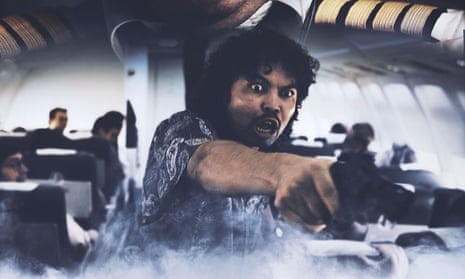Ninety-eight passengers had boarded São Paulo Airways flight 375 to Rio that morning but the man in seat 3C had a different destination in mind. As the Boeing 737-300 roared off the runway, Raimundo Nonato Alves da Conceição sat quietly clutching a backpack with a box of ammunition and a .32 caliber revolver stashed inside.
Enraged by the economic turbulence and hyperinflation convulsing Brazil as it emerged from two decades of military dictatorship in the late 1980s, the jobless 28-year-old had decided to crash a plane into Brasília’s Planalto presidential palace to kill the country’s then leader, José Sarney.
“Oh God in heaven!” the Boeing’s commander, Fernando Murilo, reportedly gasped after Nonato stormed the cockpit, shot the co-pilot dead and announced his kamikaze plan.
What followed must rank as one of the most bizarre and disturbing episodes in South American aviation history. For the next almost three hours, the pilot battled to save his passengers – and Brazil’s president – with an awe-inspiring display of aerial acrobatics that makes the 2009 landing of US Airways flight 1549 in the Hudson River look tame.
Yet for all the drama, the September 1988 incident remains little known in Brazil, let alone internationally – something the director Marcus Baldini hopes to change with his latest movie, The Hijacking of Flight 375.
“How is it that we had an episode like this – a Brazilian 9/11 – and yet nobody knows what happened? It’s astonishing,” says Baldini, who was a 14-year-old schoolboy at the time and admits having no recollection of the event.
“I think it’s the same with lots of people. When they find out, they say: ‘Wow! I had no idea!’” says Baldini, whose film will be released in December.
Baldini calls his movie an action-thriller celebrating the courage of flight 375’s commander, a “Brazilian hero” who died in 2020 without ever receiving a public thank you from the presidency. The director hopes it will be a box office hit after a bleak period for Brazil’s film industry during which Covid hammered audiences and Jair Bolsonaro’s far-right administration cut funding for the arts.
The tale of flight 375 is also infused with the history and politics surrounding Brazil’s turbulent transition back to democracy four decades ago.
Nonato’s motives have never been fully explained. According to Ivan Sant’Anna’s 2000 book on the saga, Black Box, the hijacker told police he was protesting against Sarney’s failure to tame inflation and jail corrupt politicians – a haunting presage of the anti-establishment extremism that gripped Brazil during Bolsonaro’s 2018-2023 administration and culminated in January’s assault on a presidential palace that Nonato also hoped to destroy.
Baldini sees the skyjacking as an extreme and abominable reaction to the economic tumult Brazil faced after the end of the 1964-85 regime. “It was a moment when Brazilian people harboured such great hopes over the end of the dictatorship and the start of democracy. There was this feeling that things would improve. But there were all these economic plans – and things didn’t get better,” he says.
“There was hyperinflation and people suffered so much. And there was this sense that the hopes people had of the incoming democratic government looking after them was being betrayed.
“I remember this feeling well,” the director adds. “It was one of the things that helped me understand the mindset of the characters … this feeling of hope and abandonment. Prices were out of control. There was so much hunger. So much poverty. It really knocked people off balance.”
Baldini says Nonato’s attack was “a reckless, irresponsible, absolutely awful [act] – but one which somehow personified the anger people felt at the time.”
Nonato’s meltdown began early on 29 September 1988 when he boarded flight 375 from Belo Horizonte to Rio. As it approached Rio’s international airport, he shot his way into the cockpit and ordered the pilot to fly north to Brasília, sparking nearly three hours of terror for passengers from Brazil, Germany, Iran and Japan.
after newsletter promotion
Fighter jets were scrambled and special forces troops assembled on the ground below. Eventually, Murilo decided he had to act, performing two daredevil manoeuvres that he hoped would wrongfoot the armed hijacker so that he could be subdued.
“I’d completely run out of fuel, so I thought since I’m going to die anyway, I’m going to try to do something to save myself and save everyone,” the pilot recalled in 2018, two years before he died.
First, Murilo tried a “tonneau” – a 360-degree rotation around the Boeing’s longitudinal axis. When that failed, the aviator plunged the plane into a terrifying spiral dive.
“They were extraordinarily daring manoeuvres in a plane that size,” says Baldini, admitting several actors vomited while recreating those upside-down scenes in the studio.
Murilo’s gambit worked, allowing him to perform an emergency landing in Goiânia, about 100 miles from the capital. There, the hijacker was shot and taken to hospital where he died mysteriously three days later.
A controversial coroner who had once identified the remains of the Nazi war criminal Josef Mengele in São Paulo issued a death certificate after the hospital’s doctors refused. Perplexingly, it claimed Nonato had died of sickle cell anemia. Flight 375’s passengers – and the president – all survived.
“It’s such a stunning story – and I think this kind of curiosity will attract people to the cinemas,” says Baldini, who sees parallels between his villain’s “preposterous” crime and the political extremism of the early 21st century.
“Indignation foments extreme behaviour,” the director says of a film he believes will leave audiences wondering: “How far will people go as a result of their anger?”
